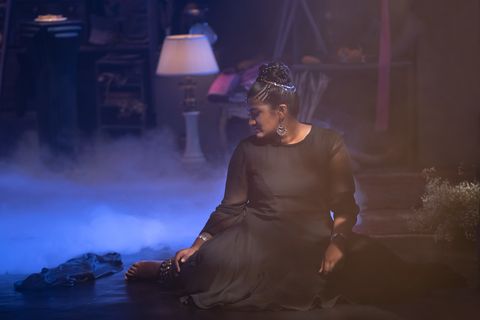Products You May Like
The soundstage at GUM Studios in Brooklyn, New York is washed in purple and pink lights, and a fog machine slowly spills a swirl of cloudy gas across the black astroturf floor. Athena Nair, a 19-year-old Tufts university student and Indian classical dancer, launches into a gorgeous kathak solo. I sit behind a bank of monitors and watch as the camera moves from the ghungroo bells on her ankles, to her graceful hands, to her face, luminous with joy as she makes the music come to life. The shot pulls out wider to give her more space to twirl and leap. Then, it happens. A rusted metal weighing scale, the kind you would see in a doctor’s office, appears in the corner of the frame, like the shark in Jaws. Athena, mid-dance, freezes. Her expression changes, the joyous light extinguished in an instant. I see her visibly wince in pain. And, behind the monitor, I burst into tears. Someone has to call cut on my behalf as I take a moment to go outside and get some air.
We are on the set of the new Disney+ docuseries Growing Up, filming an episode about Athena’s journey to self love after years of disordered eating and body dysmorphia. This is a moment that Athena and I crafted to evoke the triggering feeling of panic and fear that metal doctor’s office scale brings to anyone who has struggled with body image issues. Apparently, it was more effective than I realized—probably because when I looked at the monitor, I was really staring into a mirror.
Like Athena, I am a South Asian woman who suffers from eating disorders. My struggle with body dysmorphia began when I was told by my doctor, at six years old, that my BMI (body mass index) was too high, and I was put on the first of many diets that would come to define my life. Ever the overachiever and eager to please my concerned parents, I threw myself into controlling my weight. Since then, through adolescence and into adulthood, my self worth has been dictated by numbers: weight, waist circumference, calories in, calories out, fasting blood sugar, ketones, dress size, jeans size, grams, ounces, macros, percentages. Like so many women, I have spent my life shrouded in shame over my inability to make my body conform to those numbers—the ones I was told meant I was healthy and that I belonged.
What I didn’t know at that time was that those numbers were reflective of white, Eurocentric standards that never should have been applied to me. When I resorted to self harm to bring my body into submission, I found that I also didn’t fit the profile of a person who suffers from disordered eating. Therefore, I could easily hide my destructive behavior from my doctors, my friends, and even my family.
Pop culture and even medical research would have you believe that eating disorders are the exclusive domain of people who are wealthy, skinny, cisgender female and white. I spent a lot of time as a teenager in the ‘90s watching straight-to-television movies about young women with anorexia or bulimia, but instead of looking at them as cautionary tales, I was taking notes. Eating disorder behavior is so closely tied with whiteness and wealth, that for many—including many women of color—the depictions of it can be unintentionally aspirational. When you’ve internalized generations of self-hate over your genetically-given dark skin and curves, you’d do anything for Tracey Gold’s pale skin, gaunt eyes and razor-sharp hip bones.
I have spent my life shrouded in shame over my inability to make my body conform to those numbers—the ones I was told meant I was healthy and that I belonged.
More than 20 years later, that image hasn’t changed: from Lily Collins in To The Bone, Natalie Portman in Black Swan, or Rose Byrne in Physical, this whitewashing of eating disorders in the media has real-world consequences for women of color. In 2014, the National Eating Disorders Association (NEDA) reported that, “exact statistics on the prevalence of eating disorders among women of color are unavailable” because, “due to our historically biased view that eating disorders only affect white women, relatively little research has been conducted utilizing participants from racial and ethnic minority groups.” More recent research shows that women of color are as, if not more, affected than white women by anorexia nervosa, bulimia nervosa, and binge eating disorder, the three recognized types of eating disorders. Women of color are also under-diagnosed for eating disorders, thanks to medical bias and lack of access to quality healthcare.
With Growing Up, I saw an opportunity to stop the erasure of the many types of people, like me, who fly under the radar of research, treatment, and support. As South Asian women, Athena and I wanted to frame this topic through our specific cultural lens: from the subtle demands for perfection to the pressure to conform to white beauty standards to the earnest desire to unburden our hard-working immigrant parents of our problems, causing us to try to deal with our demons in secret.
I realize now that my burst of tears on set was catharsis; a recognition after decades of isolation that I wasn’t alone in my struggle with my body. Athena taught me to look at eating disorder recovery as activism—a way to reject decades of bad science and colonialist beauty standards. Working with her to share her story moved me in profound ways. For the first time, I felt optimistic not only that recovery was possible, but so was radical self love.
“What if you didn’t have to hate your body before you could love your body?” Athena, now an activist and board member of The Body Positive, asks in one of the most powerful moments of our episode of Growing Up. That question struck me like a thunderbolt when I first heard it, and has stayed with me ever since. It won’t be easy to deprogram ourselves of a lifetime of internalized ideals, but we owe it to ourselves, and to future generations, to try.
Hopefully by sharing Athena’s story, more young women—and men, and non-binary folks—who feel unseen by a system centered around the needs of white women, will seek treatment and find community. Because being seen is the first step toward healing.
Smriti Mundhra is a director, producer and writer whose work spans fiction and non-fiction. As a director and creator, she has been nominated for an Academy Award, a primetime Emmy Award, an NAACP Image Award and a Humanitas Prize. She has also won a DGA Award and a Critic’s Choice Award, and was named one of DOC NYC’s 40 Under 40 Filmmakers to Watch. Her latest film, St. Louis Superman, was nominated for a 2020 Academy Award in the short documentary category, won a Critics’ Choice Award for Best Short Documentary and is a finalist for a duPont Prize. It was also named one of the International Documentary Association’s Documentaries Of The Decade. Smriti also created and executive produced Indian Matchmaking, an eight-part Netflix original documentary series currently streaming on the platform, and directed Shelter, a DGA Award-winning and NAACP Image Award-nominated documentary for HBO Max and Sesame Workshop. “Through our eyes: Shelter” was recently nominated for a 2022 Emmy for Outstanding Short Documentary. Her upcoming work includes a civil rights docuseries for HBO and “Growing Up” a coming-of-age docuseries for Disney+, executive produced by Brie Larson.

